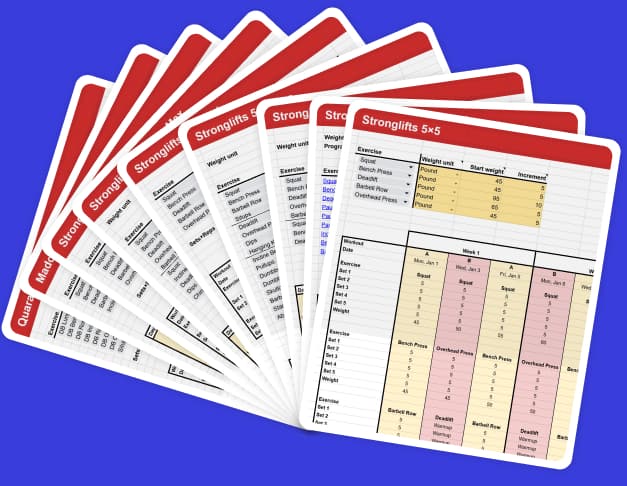Assistance work is not necessary. Most of your strength and muscle gains will come from doing the main Stronglifts 5×5 exercises. Your arms will not stay small if you only do compound lifts without isolation. They’ll grow.
But maybe you have time to do more than the main lifts of Stronglifts 5×5. If so, you can add extra accessory exercises for your biceps, triceps, abs, chest, back or even glutes. This will take an extra 15min/workout.
Here’s how to add assistance work to Stronglifts 5×5.
Contents
- Assistance Work for Biceps/Abs
- Assistance Work for Chest/Back
- Women Assistance Work for Glutes & Abs
- Frequently Asked Questions
- Is isolation necessary for bigger arms?
- How much more muscle will I gain?
- How much will my arms grow?
- Is assistance work worth it?
- Why do bodybuilders train arms directly?
- What do you do for arms?
- Who should add assistance work?
- Who shouldn’t do assistance work?
- How long does the assistance take?
- How to progress biceps curls?
- How to progress on Pullups and Dips?
- What if I can’t do one Pullup?
- How to progress on ab exercises?
- How to get the most out of assistance work?
- Why not do 5×5 on assistance lifts?
- How long should I rest between sets?
- References
Join the Stronglifts community to get free access to all the spreadsheets for every Stronglifts program. You’ll also get daily email tips to stay motivated. Enter your email below to sign up today for free.
Assistance Work for Biceps/Abs
You can easily add assistance work for your biceps and abdominal muscles to each Stronglifts 5×5 workout. Here’s how:
| Stronglifts 5×5 with Assistance Work for Biceps/Abs | |
|---|---|
| Workout A | Workout B |
| Squat 5×5 | Squat 5×5 |
| Bench Press 5×5 | Overhead Press 5×5 |
| Barbell Row 5×5 | Deadlift 1×5 |
| Pullup 3×8 | Barbell Curl 3×8 |
| Hanging Knee Raises 3×8 | Planks 3×30sec |
This assistance works your arms and abs like this…
- Workout A works your arms with three compound lifts: Bench, Rows and Pullups. The latter two exercises work your biceps (1, 2).
- Workout B works your arms with two exercises: Overhead Press and Barbell Curls. The press works your triceps, curls work your biceps.
- Workout A works your abs with Hanging Knee Raises. Workout B works them with Planks. You’re also getting abdominal work from doing the Squats, Overhead Press, Pullups, etc (3, 4).
Let’s look at the total volume for your arms when you add this assistance work to Stronglifts 5×5. We’ll use the weekly set average because you alternate workouts A and B. For example, you Barbell Row twice in the A/B/A weeks. That’s 10 sets/week for biceps. But you Row once in the B/A/B weeks. That’s 5 sets. So we’ll use the average of 7.5 sets/week for biceps.
| Sets/week | Stronglifts 5×5 | +Assistance Biceps/Abs |
|---|---|---|
| Triceps | 15 | 15 |
| Biceps | 7.5 | 17.5 (+133%) |
| Exercises | Bench, Overhead Press, Row | Bench, Overhead Press, Row, Pullup, Barbell Curl |
Adding Biceps/Abs assistance work to Stronglifts 5×5 increases the volume for your biceps by 10 sets per week. This extra volume comes from adding Pullups to workout A and Barbell Curls to workout B. On top of that you’re also adding nine weekly sets for abs with Planks and Hanging Knee Raises.
You can enable this assistance work in the Stronglifts app. Tap program – Stronglifts 5×5. Pick your template, tap assistance work.
Assistance Work for Chest/Back
This assistance work adds volume for your chest, back, biceps and triceps by adding two exercises to each workout. It uses a combination of compound and isolation exercises. I think it’s superior to the Biceps/Abs version as it gives you more bang for your buck. Here’s how it works…
| Stronglifts 5×5 with Assistance Work for Chest/Back | |
|---|---|
| Workout A | Workout B |
| Squat 5×5 | Squat 5×5 |
| Bench Press 5×5 | Overhead Press 5×5 |
| Barbell Row 5×5 | Deadlift 1×5 |
| Pullup 3×8 | Dips 3×8 |
| Skullcrushers 3×8 | Barbell Curl 3×8 |
Let’s compare the volume of the main lifts of Stronglifts 5×5 with the addition of this assistance work. We’ll use the weekly set average again because you alternate weeks of workout A/B/A with B/A/B.
| Sets/week | Stronglifts 5×5 | +Assistance Chest/Back |
|---|---|---|
| Chest | 7.5 | 12 (+60%) |
| Back | 9 | 15.5 (+72%) |
| Shoulders | 15 | 19.5 (+30%) |
| Triceps | 15 | 24 (+60%) |
| Biceps | 7.5 | 20 (+167%) |
| Exercises | Bench, Overhead Press, Row | Bench, Overhead Press, Row, Pullup, Dips, Curl, Skullcrushers |
The Chest/Back assistance work increases the volume for your upper-body by 18 sets per week on average. This adds 22% volume for your upper-body compared to when you only do the main lifts of Stronglifts 5×5.
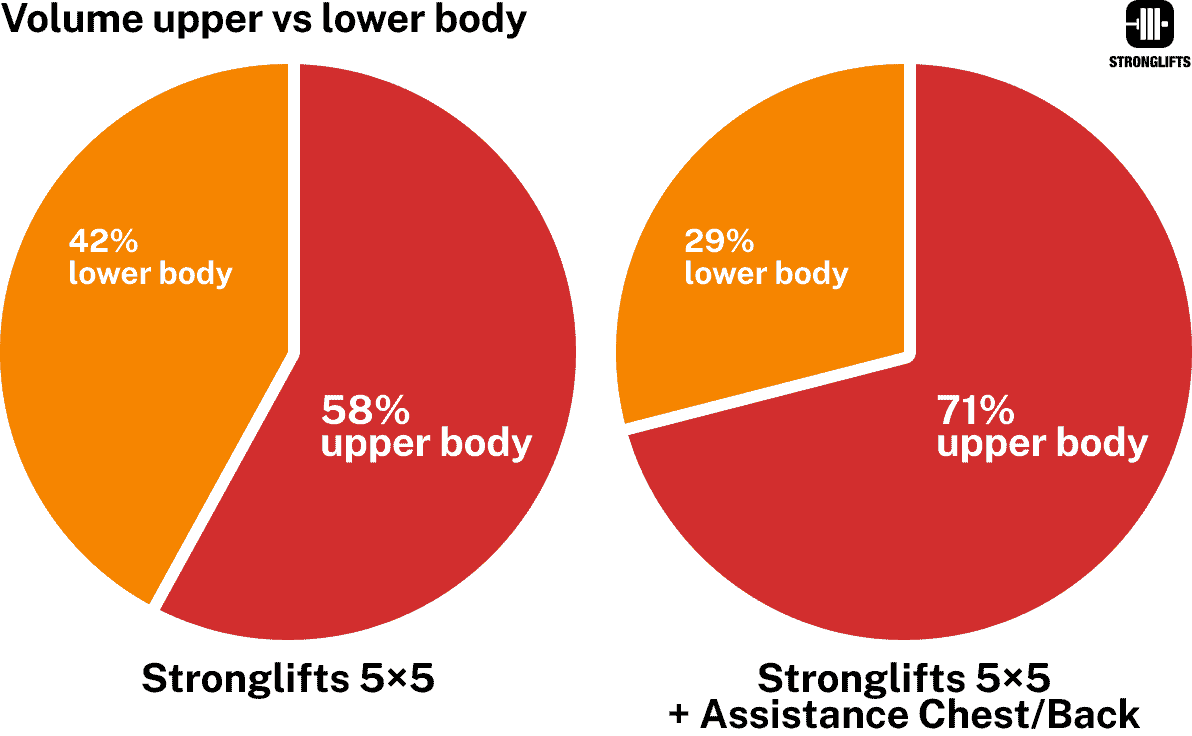
You can enable this assistance work in the Stronglifts app. Tap program – Stronglifts 5×5. Pick your template, tap assistance work.
Women Assistance Work for Glutes & Abs
Female Stronglifters were kind enough to remind me that women aren’t interested in the same muscles as men. While guys typically focus on chest and biceps, women are more concerned about their glutes and abs.
Here’s how you can add extra exercises for these muscles…
| Stronglifts 5×5 with Assistance Work for Glutes & Abs | |
|---|---|
| Workout A | Workout B |
| Squat 5×5 | Squat 5×5 |
| Bench Press 5×5 | Overhead Press 5×5 |
| Barbell Row 5×5 | Deadlift 1×5 |
| Romanian Deadlift 3×8 | Hip Thrust 3×8 |
| Hanging Knee Raises 3×8 | Planks 3×30sec |
This adds an extra nine sets per week for your legs as well as your abs. Be warned that Stronglifts 5×5 already has quite a lot of volume for your legs with all the Squats and Deadlifts. When my wife did the program, she didn’t do any extra assistance work. Yet her glutes developed fine. You should expect diminishing returns from adding more exercises that work the glutes.
In fact, a study by Plotkin et al had one group of beginners do nine weeks of Hip Thrusts (5). The other group did nine weeks of Squats. They felt the Hip Thrusts more in the glutes than Squats. But there was no difference in muscle gains of the glutes. The hypertrophy gains were similar for both lifts. So there doesn’t seem to be anything special about Hip Thrusts. It’s more about adding exercises for the glutes to increase your training volume.
Nevertheless, you can enable this assistance work in the Stronglifts app. Tap program – Stronglifts 5×5. Pick your template, tap assistance work.
Frequently Asked Questions
Is isolation necessary for bigger arms?
No, not for the large majority of people.
Many lifters believe that their arms will remain small if they don’t do isolation exercises to directly work their biceps and triceps. In fact, when I found the 5×5 workout in 2003, I was scared that my arms would shrink to their pre-lifting size. The program didn’t have five different curl exercises like I was used to. And yet to my surprise, my arms didn’t shrink.
Since then, several studies have compared doing only compound exercises versus doing compounds plus isolation exercises (1, 2, 6, 7). Every study found that your arms don’t stay small when you only do compound exercises like the Bench Press and Barbell Row. They grow in size.
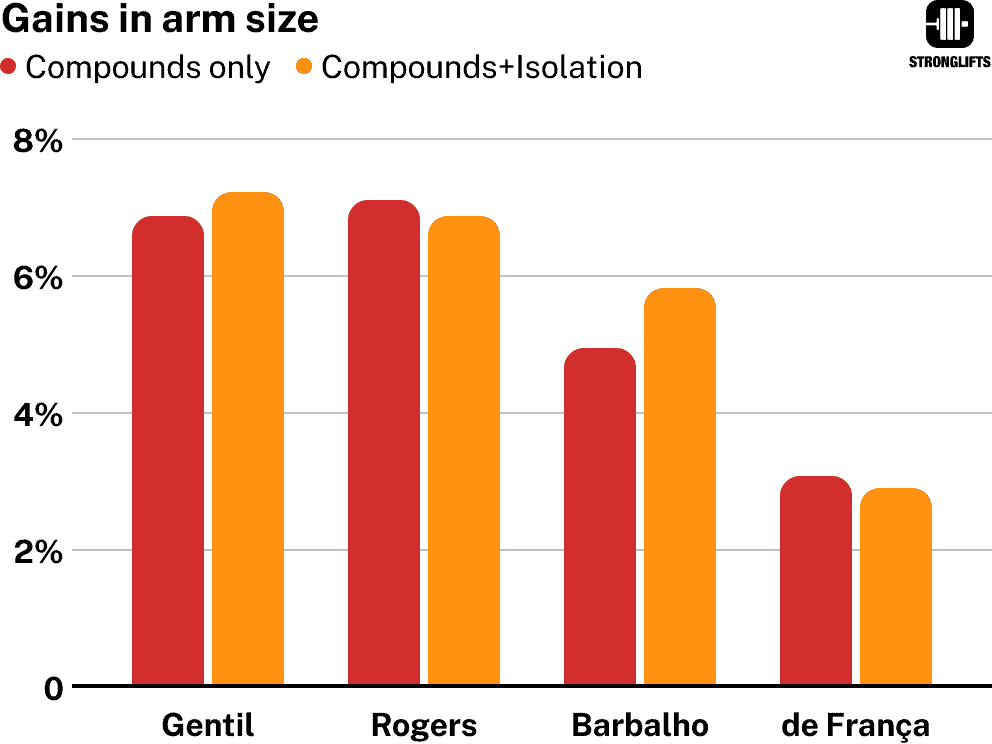
These studies have found that adding isolation exercises like curls make little to no difference in arm size (1, 2, 6, 7). The compound exercises provide enough stimulation for the arms to grow bigger. And so the idea that your arms will remain small if you only do compounds is simply false.
This point was made in a study by Schoenfeld et al who reviewed all the relevant literature (8). Quote…
…. while it appears clear that substantial hypertrophy of the limbs can be achieved by only performing MJ exercises [multi-joint or compound exercises], it remains equivocal whether additional benefits can be derived from SJ exercises [single-joint or isolation exercises].
Schoenfeld et al, 2019 (8),
Beginners often have simplistic ideas about exercises. They think “bench is for chest”, “rows is for back” and “Squats is for quads”. They forget that these are COMPOUND exercises – they work several muscles at the same time. Your shoulders and triceps work hard when you Bench Press (9, 10). These aren’t dumbbell flyes where your chest does most of the work.
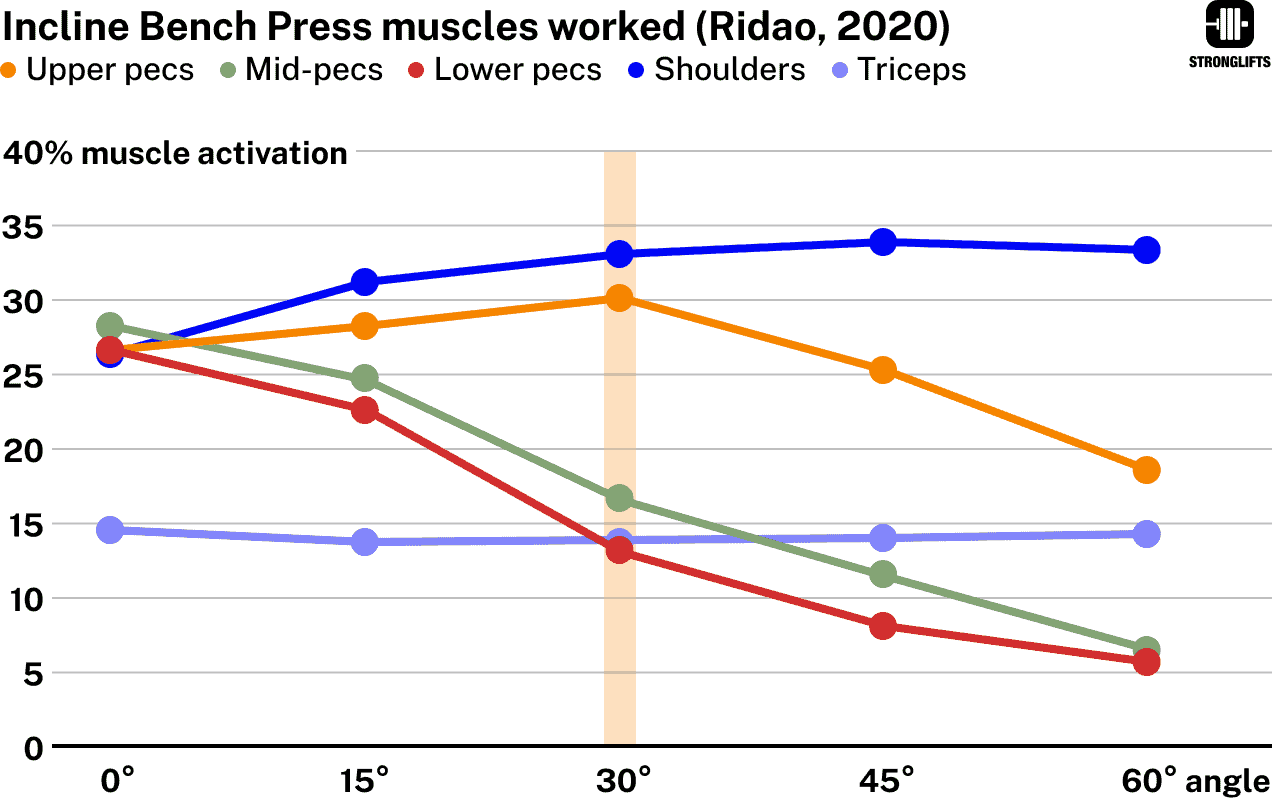
This illustration shows that the Bench Press doesn’t just work your chest. Your shoulders are one of the primary muscles that help you to push the weight off your chest. Your triceps also help you push the weight by straightening your arms on the way up. That’s why they don’t stay small if you only Bench. They work to lift the weight. This stimulates growth. The same thing happens with Barbell Rows – they don’t just work the back but also your biceps.
For example, a study by Ogasawara et al had beginners Bench Press three times per week for six months (11). Their chest got 37% bigger. However, their triceps also got 16% bigger. These muscles didn’t stay small even though they didn’t train them directly with isolation. They grew in size because your triceps work to push the bar away when you Bench Press.
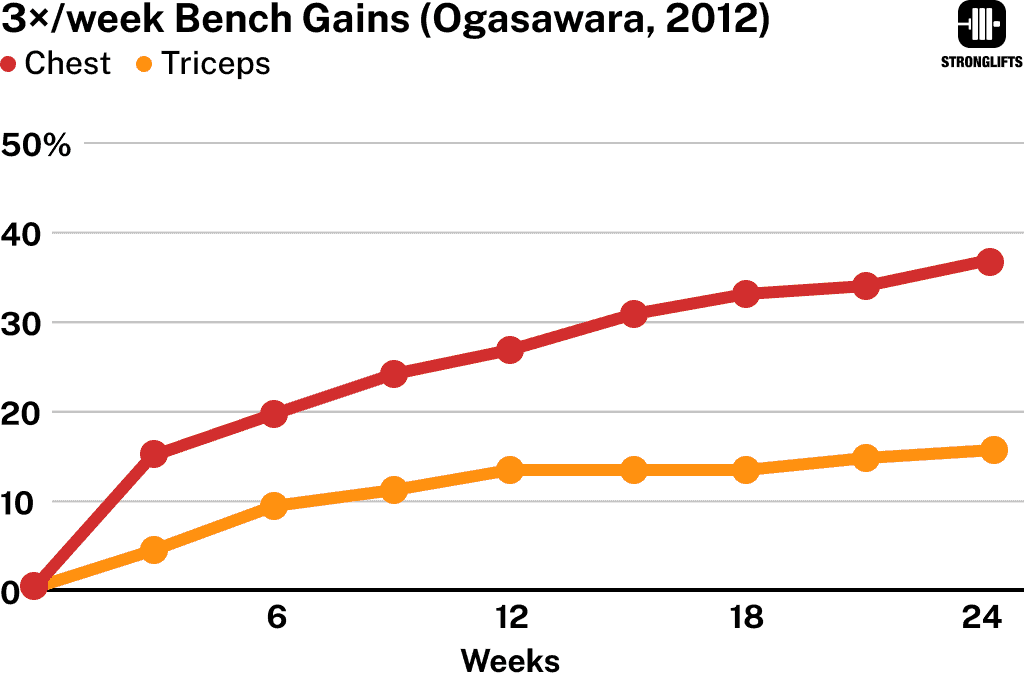
Bodybuilding has taught many gym goers to think in terms of muscles instead of movements. You may believe that the bench is only for chest and rows are only for back. But your body doesn’t think in terms of isolation. It will use every muscle it can use to Bench Press or Barbell Row a heavy weight. It will do that because it makes the weight easier to lift. Your arms will work to push or pull heavy weight. This effort results in muscle growth.
It’s a myth that your arms will stay small if you only do compound lifts. Heavy Presses and Rows stimulate your arms to grow bigger. Isolation exercises like Biceps Curls can help to grow your arms a little bit bigger. But they aren’t an absolute necessity, especially if you’re a new or returning lifter.
How much more muscle will I gain?
Not much. Most of your muscle gains will come from doing the main lifts.
Progressive overload is the main driver of muscle growth (12). In order to build muscle, you need to challenge your body by doing more work over time. The simplest way to do this is by adding weight on the bar.
However, doing just one heavy set per week wouldn’t be enough to maximize your muscle gains. You have to do enough weekly sets or volume too (13, 14). A study by Schoenfeld et al analyzed how many sets per week you need per muscle group to build muscle (15). Here’s what they found…
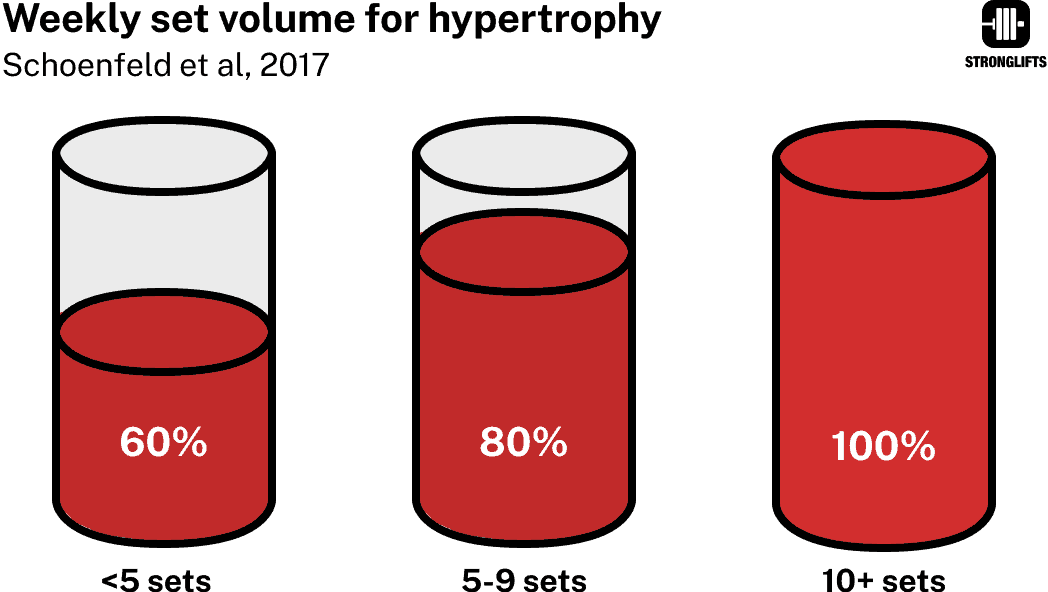
You get about 60% of the muscle gains if you do less than 5 sets per muscle per week. You get about 80% of the muscle gains if you do 5-9 sets per week. And you get 100% of the gains if you do 10 weekly sets or more. You can use this information to check how much volume a program has for each muscle.
Let’s check the volume of Stronglifts 5×5 when you only do the main lifts. We count the weekly sets per muscle group. We then take the weekly set average because you alternate weeks of workouts A/B/A with B/A/B.
| Muscle | Sets | Volume |
|---|---|---|
| Chest | 7.5 | Medium |
| Back | 9 | Medium |
| Shoulders | 15 | High |
| Triceps | 15 | High |
| Biceps | 7.5 | Medium |
| Legs | 16.5 | High |
Stronglifts 5×5 is high volume for your shoulders, triceps and legs. It’s medium volume for your chest, back and biceps.
A common beginner mistake is to misinterpret this to mean that medium volume does nothing. Beginners often jump to high volume from day one because they want results fast. But the research is clear: medium volume does build muscle. A lot of muscle. High volume only results in an extra 20% of muscle gains (15). You get diminishing returns for your efforts.
It’s also important to put this into context…
- Stronglifts 5×5 is aimed at new or returning lifters. The upper-body is typically less trained when they start lifting (16). It needs less volume to progress than the legs which are more trained (17, 18, 19).
- Stronglifts 5×5 is not a program that you’ll do forever. You’ll switch to Stronglifts 5×5 Intermediate later. That will increase the volume for your chest to 20 sets per week. So more is coming either way.
Nonetheless, adding the Chest/Back assistance work to Stronglifts 5×5 turns everything high volume. You’re now doing more than 10 sets per week for every muscle group, including your chest, back and biceps.
| Sets/week | Stronglifts 5×5 | +Assistance Chest/Back |
|---|---|---|
| Chest | 7.5 | 12 (+60%) |
| Back | 9 | 15.5 (+72%) |
| Shoulders | 15 | 19.5 (+30%) |
| Triceps | 15 | 24 (+60%) |
| Biceps | 7.5 | 20 (+167%) |
| Exercises | Bench, Overhead Press, Row | Bench, Overhead Press, Row, Pullup, Dips, Curl, Skullcrushers |
In theory you can expect an extra 20% of muscle gains by adding assistance work to Stronglifts 5×5. Keep in mind that this will increase your gym time by 15min/workout. That’s an extra 45min/week or three hours per month.
How much will my arms grow?
Many factors influence how much more your arms will grow when you add assistance work to Stronglifts 5×5. A major one is the size of your arms.
An experienced lifter with 15″ arms should expect smaller gains than a new lifter with 12″ arms. The more muscle you already have, the harder it is to build even more muscle. You get diminishing returns for your efforts (20, 21). It’s easier to take your arms from 12″ to 15″ than from 15″ to 18″. If that wasn’t the case, everyone would have 24″ arms like Ronnie.
For example, one study had one group of beginners do compound exercises only for eight weeks (2). The other group did the same compound lifts but with extra isolation for the biceps and triceps. They did three sets on all exercises. Here’s the workout they did 2x/week for the upper-body…
| Barbalho et al, 2018 | Compounds only group | Compounds + isolation group |
|---|---|---|
| Compounds | Bench, OHP Pulldown, Row | Bench, OHP Pulldown, Row |
| Isolation | × | Cable Triceps Barbell Curl |
| Sets/week | 24 | 36 |
They measured the arms of these 20 beginners before starting the study, and after eight weeks of training. Here were the results…
| Barbalho et al, 2018 | Compounds only group | Compounds + isolation group |
|---|---|---|
| Height | 175cm / 5’9″ | 175cm / 5’9″ |
| Weight | 75kg / 165lb | 73kg / 161lb |
| Biceps before | 30.4cm / 11.97″ | 30.6cm / 12.05″ |
| Biceps after | 31.6cm / 12.44″ | 32.2cm / 12.68″ |
| Gain | +1.2cm / 0.47″ | +1.6cm / 0.63″ |
Their arms grew by about half an inch in eight weeks. The group that did the extra isolation exercises got an extra 0.4cm or 0.16″ out of that.
Compare this to a similar study by França et al but on experienced lifters (1). They had twenty guys with two years of gym experience train for eight weeks. Half did compound exercises only. The other half did the same compound lifts but with extra isolation for the biceps and triceps. They did four workouts per week, alternating two workouts A and B. On every exercise they did three sets. They did not train their lower body.
| França et al, 2015 | Compounds only group | Compounds + isolation group |
|---|---|---|
| Workout A | Incline Bench Flat Bench Decline Bench Weighted Pushups OHPress | Incline Bench Flat Bench Decline Bench Weighted Pushups OHPress |
| × | Triceps Pushdowns Neutral grip pushdowns |
|
| Workout B | Lat pulldown Machine Row Supinated Pulldown Cable Row Upright Row | Lat pulldown Machine Row Supinated Pulldown Cable Row Upright Row |
| × | Standing dumbbell curl Seated dumbbell curl |
|
| Sets/week | 60 | 84 |
They measured the arms of these 20 experienced lifters before starting the study, and after eight weeks of training. Here were the results…
| França et al, 2015 | Compounds only group | Compounds + isolation group |
|---|---|---|
| Biceps before | 37.85cm / 14.91″ | 37.95cm / 14.95″ |
| Biceps after | 38.50cm / 15.16″ | 38.50cm / 15.16″ |
| Gain | 0.65cm / 0.26″ | 0.55cm / 0.22″ |
Their arms grew by about a quarter of an inch in eight weeks. This is about half what the beginners in the previous study gained in the same amount of time. Note how the extra isolation exercises didn’t make a difference in this study. The gains in arm size were similar for both groups.
These two studies beautifully illustrate the law of diminishing returns. The more muscle you have, the more work and effort it takes to build even more muscle. In contrast, the less muscle you have, the less you need to do to build more muscle, and the faster the gains. Compare…
| Barbalho et al, 2018 | França et al, 2015 | |
|---|---|---|
| Experience | Beginner | Experienced |
| Program | 8 weeks | 8 weeks |
| Sets/week | 24-36 | 60-84 |
| Arm growth | ~0.5″ | ~0.2″ |
The beginners with 12″ arms gained about 150% more in arm size than the experienced lifters with 15″ arms. Yet they did about 60% less volume. They gained more despite doing less because they were less trained. You don’t need to do a lot of volume if you’re a new or returning lifter.
Is assistance work worth it?
Depends on your priorities.
Many guys spend years trying to grow bigger arms for the wrong reasons, only to discover that the results weren’t what they expected…
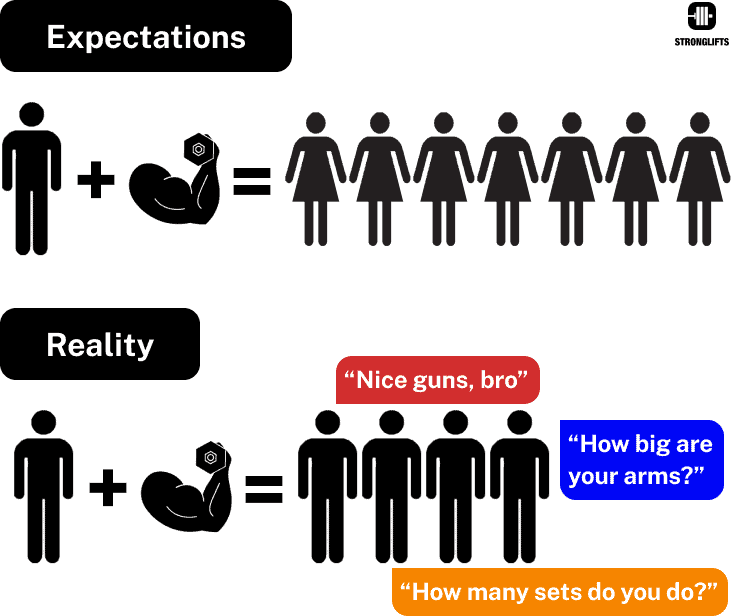
Now if you’re a competitive bodybuilder, maximizing the size of your arms is crucial. A mere difference of 0.2 inches can be the difference between placing on the podium or not. For such lifters, dedicating an extra hour per week in the gym specifically to arm training makes total sense. It’s a necessity. That’s why bodybuilders usually incorporate assistance exercises for arms (22).
The same holds for fitness influencers on Youtube, Instagram, TikTok, etc. They need to build impressive physiques to attract followers. Beginners are often obsessed with the biceps, and big arms draw attention. Influencers are therefore willing to spend an inordinate amount of time training arms. It helps them earn a living through sponsorships and other income streams.
On the other hand, if you’re say a busy father managing work and family, spending an extra hour in the gym each week just to make your arms a little bigger will seem silly. Most people lack time to train (23, 24, 25). Many don’t even like going to the gym. Lots of people would rather spend 50% less time in the gym if it means only missing out on 20% on potential gains. Again, your arms won’t stay small if you only do compound lifts. They’ll grow.
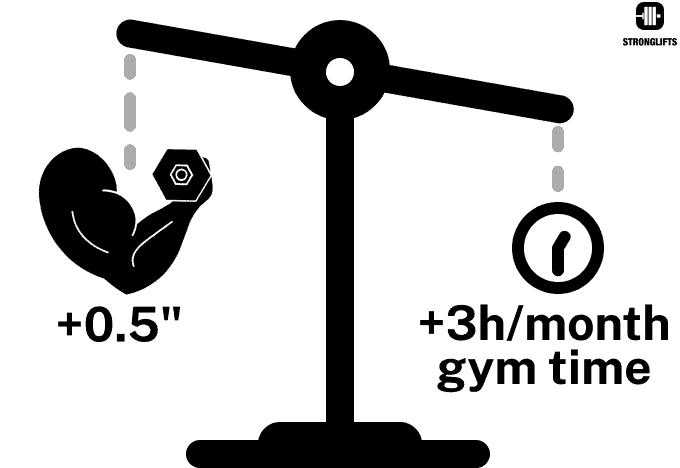
A common beginner mistake is to copy the workouts of advanced lifters like competitive bodybuilders without considering their own goals and priorities. Most people aren’t looking to maximize their muscle mass. They just want to be stronger, fitter, and look better. Compound lifts grow bigger arms. Spending an extra three hours per month in the gym just to get your biceps an extra half an inch bigger is a bad return on investment for most people. That time is better spent doing cardio to improve your overall health and fitness.
Why do bodybuilders train arms directly?
Bodybuilders are judged on the size of their arms in competition. An extra 0.2″ in arm size can be the difference between placing on the podium or not. They have to train their arms directly in order to maximize the size of their biceps and triceps. It’s a competitive disadvantage to not do so.
Think of it this way: doing compound exercises only can grow your arms from say 11″ to 15″. That will make you stand out in most gyms. Few drug-free lifters of normal body-weight have 15″ arms (really). However, if you want to compete in bodybuilding, 15″ arms won’t be big enough to win. You’ll need to add isolation exercises to grow them to 16-17″ in size. This is the 80/20 rule: compounds get you 80% of the arm growth. To get another 20% gains, you need to add isolation exercises like pro bodybuilders do.
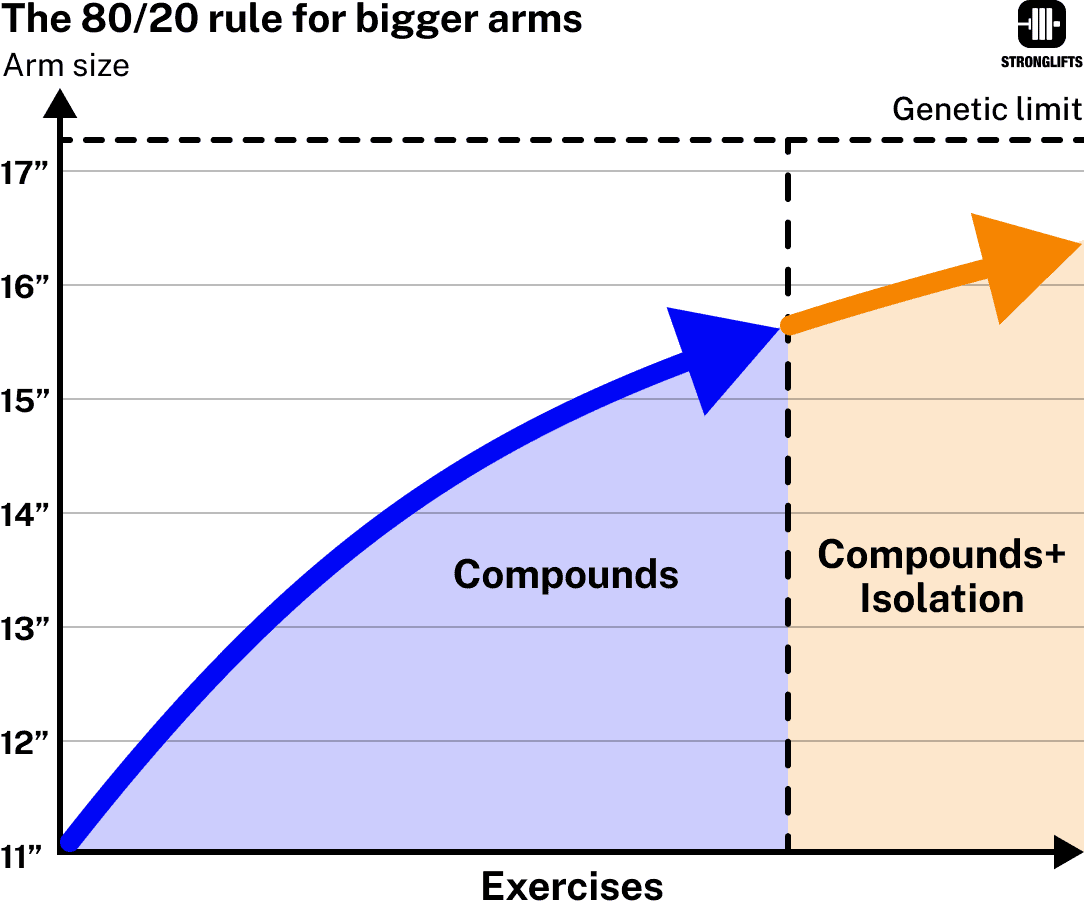
Most people aren’t trying to win bodybuilding contests. You won’t have to do a double biceps pose next to a freak who spent the last two years training five to six days a week to get an extra 0.5″ on their already huge 16.5″ arms. You probably lift in a gym where most people don’t even add weight on the bar to drive muscle growth. It’s not hard to stand out from the masses.
A study by Katch et al compared the muscle size of bodybuilders, powerlifters and olympic weightlifters (26). Bodybuilders usually do more isolation for their arms (22, 27). Powerlifters aren’t judged on their arm size when they compete – just like you. Powerlifters mostly do compound lifts. Yet the study found that bodybuilders only had 3.2% more muscle than powerlifters (26).
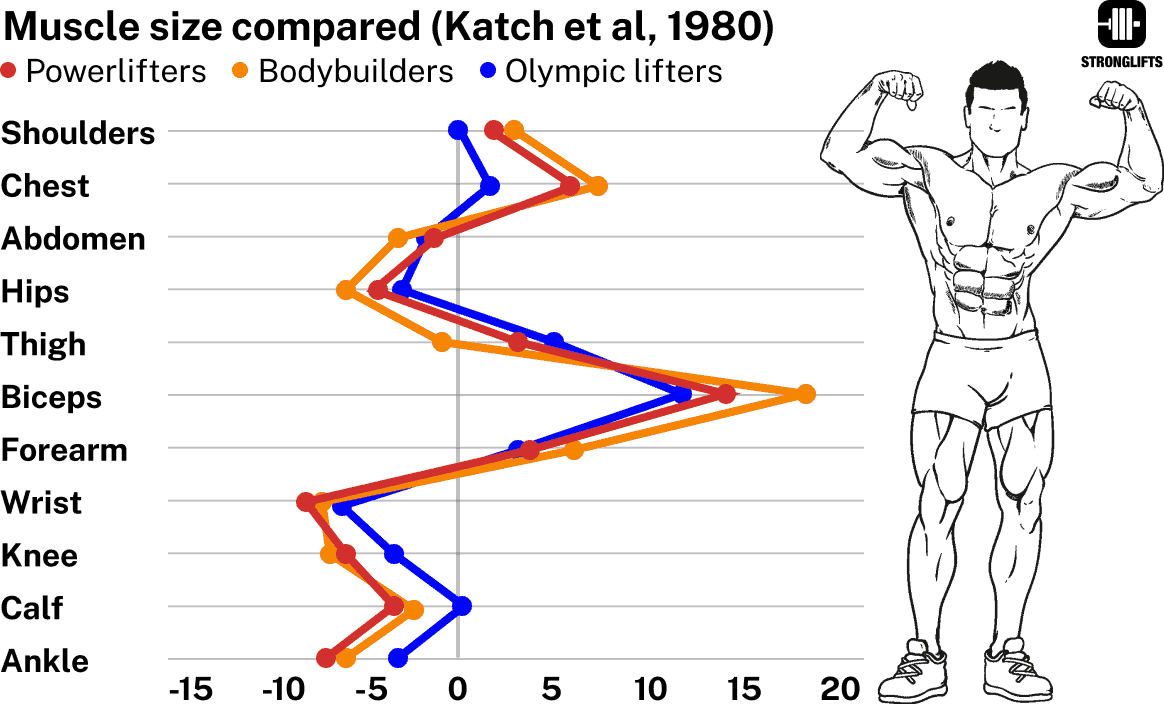
Bodybuilders have bigger arms than powerlifters. But this study shows that the difference isn’t as big as most people think. Compare…
| Katch et al, 1980 | Bodybuilder | Powerlifter | Difference |
|---|---|---|---|
| Height | 177cm 5’8″ | 173cm 5’7″ | |
| Body-weight | 82.4kg 182lb | 80.8kg 178lb | |
| Body-fat | 9.3% | 9.1% | |
| Biceps flexed | 40.4cm 15.9″ | 38.9cm 15.3″ | 1.5cm / 0.6″ (3.71%) |
| Forearm | 30.7cm 12.1″ | 29.8cm 11.7″ | 0.9cm / 0.4″ (2.93%) |
| Workouts | 5×/week | 4×/week |
Again, getting your biceps 0.5″ bigger is a must for competitive bodybuilders. It can be the difference between placing on the podium or not. But obsessively training small muscles like the biceps just to get half an inch extra growth isn’t worth the time investment for most people. In fact, the study says…
It is evident that BB (bodybuilders) have higher values of excess muscle (3.2% higher than PWL powerlifters) which probably reflects their unusual preoccupation with muscle hypertrophy.
Katch et al, 1980 (26)
One could argue that the bodybuilders have disproportionately big arms. The arm size of powerlifters can be considered more suitable and balanced as it’s the natural byproduct of doing compound exercises. Some may find that more aesthetically pleasing and dislike the exaggerated look of bodybuilders.
What do you do for arms?
I’m a recovering arm-oholic.
During the first five years of my training career, I trained arms every Sunday. I spent almost two hours doing ten different exercises. Five for biceps, five for triceps. All isolation. It was way too much volume. On top of that every set was taken to failure, with many past failure using forced reps. It was the most painful workout of the week next to my leg day. I never liked it.
I did it anyway because bodybuilding told me you have to train a muscle directly and work it from every angle, or it won’t grow. That’s why I was so skeptical when I found the 5×5 workout. The program didn’t have any isolation exercises for biceps and triceps. It went against everything I thought I knew about training at the time. I was so afraid that my arms would shrink back to their pre-lifting size. It all seems so silly thinking about this now. But I was a rookie, and the muscle magazine brainwashing ran deep…
21 years later, my “arm work” consists of heavy rows, pullups, presses, and dips. I’m happy with the size of my arms, and rarely do direct arm work like biceps curls. I’ll do it if we need to make a video for the Stronglifts app. Other than that I don’t care about the biceps. They’re small muscles. They don’t deserve all the attention most gym goers give them. I’ll take an extra 5lb on my Squat over an extra 0.5″ in arm size any day.
But that’s just me. My younger self would have disagreed. Some of my clients have direct arm work in their program because they care about that. I don’t have issues with this. You can add assistance work in the Stronglifts app. Tap program – Stronglifts 5×5. Pick your template, tap assistance work.
Writing about this topic has actually gotten me curious. I’ve recently started to do direct arm work to see what impact it would have. I’ll update this article with the results of my experiment once I’ve been doing this for long enough.
Who should add assistance work?
You should add assistance work to Stronglifts 5×5 if…
- You enjoy training arms. You like the “pump” sensation during curls where your muscles fill up with fluid. It makes you feel more in control of the muscle building process. It makes you feel more confident.
- You’re in a rush to build bigger arms. Isolation exercises can grow your arms faster initially because they’re less technical (28). It’s easier to learn how to do a proper curl than a row. You can load curls heavily faster which results in quicker muscle gains initially. Once you have the form down on Rows and can lift heavy, the gains catch up.
- You’re not new to lifting. You were doing a different program before Stronglifts 5×5 that included a lot of arm work. If you care a lot about your arm size, it would make sense to continue to do the same amount of volume. But you may want to reduce the direct arm work somewhat to account for the possibly higher volume of presses and rows.
If you’re looking to maximize the size of your arms, you’ll need to do isolation exercises for biceps and triceps. However, maximizing your muscle mass is a process that takes years. It does not happen over a few months. Stronglifts 5×5 is not a program that you’ll do forever. It’s a program for new or returning lifters. Therefore, the purpose of the program is not to maximize as that requires doing many different programs over the years.
You can add assistance work in the Stronglifts app. Tap program – Stronglifts 5×5. Pick your template, tap assistance work.
Who shouldn’t do assistance work?
You should probably not add assistance work to Stronglifts 5×5 if…
- You don’t have much time to train. Your arms will grow bigger from doing the main lifts. So just stick with the main lifts. If you want to do more, add cardio to improve your overall fitness and health. Cardio beats curls, especially if you’re heavier and not in shape.
- You’ve had issues with your elbows and wrists. A common beginner mistake is to jump from doing nothing to five different curl exercises on top of all the Rows and Presses. This can easily result in aches and pains that can be difficult to get rid of. Your tendons need more time to adapt to the workouts and grow stronger than your muscles.
- You’re new to lifting. Your arms will grow bigger from just doing the main lifts. Starting with less makes it less likely that you develop aches and pains. When you plateau, you’ll have room to increase the volume to drive more progress. If you start with a lot of extra exercises, it’s harder to keep up and you have nowhere to go when you plateau.
How long does the assistance take?
About 15min/workout or ~3h/month.
According to our data of thousands of Stronglifters using the Stronglifts app, the average duration of a Stronglifts 5×5 workout is about 45min. Assistance work will add about 15min per workout if you’re strict with your rest times.
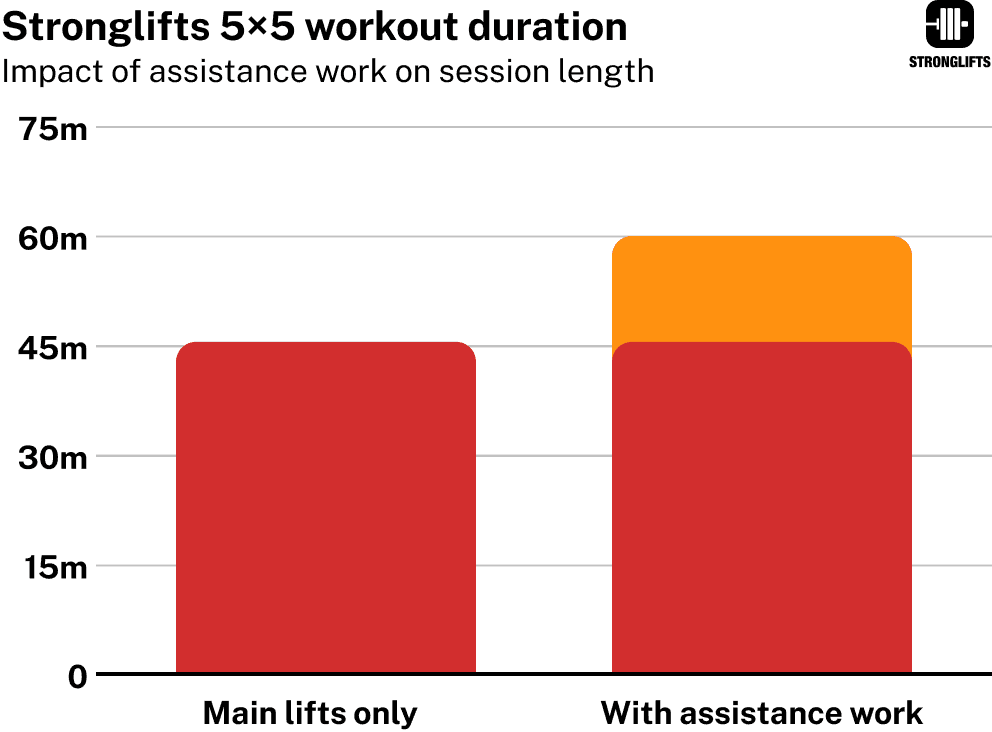
Here’s the math for the workout duration:
- There’s little to no need to warmup for the assistance work because you’re already warmed up from doing the main lifts. Start right after finishing Rows or Deadlifts and putting the equipment away.
- Each set takes at most 30 seconds to perform.
- Two assistance exercises done for three sets each will therefore take an extra 15min per workout or 45min/week.
You can add assistance work in the Stronglifts app. Tap program – Stronglifts 5×5. Pick your template, tap assistance work.
How to progress biceps curls?
Add weight over time.
Progressive overload is the main driver of muscle growth (12). This applies to every muscle, including your arms. The goal when you do barbell curls isn’t to get pumped, sore or any of that. These things may happen but they’re not what drives muscle growth. You need to add weight on the bar over time to stimulate your arms to grow stronger and bigger. The researchers do this all the time in exercise studies. For example…
…. when they were able to perform more repetitions than suggested, the load was increased (1 to 5 kg) in alignment with the desired repetition range for the next training session.
Barbalho et al, 2018 (2).
Adding weight is harder on isolation exercises because they only use one muscle at a time. You should therefore use the smallest increments you have available. Many gyms don’t have plates smaller than 2.5lb. This forces you to progress in 5lb steps. But adding 5lb to a 65lb curl is an increase of 7.7%. That’s like adding 15lb to a 200lb Bench. It’s hard to sustain.
Notice how in the above study they used increments of only 1kg or 2lb. Some people love to make fun of scientists – “do they even lift?!?”. But this example shows they often know better how to train than your average gym bro. They used fractional plates of 0.5kg or 1lb. Here are some options for that:
- Rogue 1lb and 0.25lb plates
- Everymate 1lb and 0.25lb plates
- Strength Shop – 0.5kg and 0.125kg
- Rogue 0.5kg and 0.125kg plates
The Stronglifts app supports fractional plates. Go to start workout – tap the weight – tap plates at the bottom – add your fractional plates. Then go back to the increment setting, and lower that from 5lb to 2.5lb or less.
How to progress on Pullups and Dips?
Add weight over time by using a dip belt.
Dip belts have chains to which you hang plates from your waist. This allows you to progress on Pullups and Dips by adding weight.
Many lifters are surprised to find out that adding weight is easier than adding reps. It’s a common mistake to think that one extra rep is easier than 2.5lb. Maybe because the number looks smaller. But adding weight is easier.
Here’s a standard one rep max table. It shows you how many reps you can expect to do with a given percentage of your max.
| Reps | Percentage | Difference |
|---|---|---|
| 1 | 100% | |
| 2 | 95.5% | 4.5% |
| 3 | 92.2% | 3.3% |
| 4 | 89.2% | 3.0% |
| 5 | 86.3% | 2.9% |
| 6 | 83.7% | 2.6% |
| 7 | 81.1% | 2.6% |
| 8 | 78.6% | 2.5% |
| 9 | 76.2% | 2.4% |
| 10 | 73.9% | 2.3% |
The difference between reps is about 2.5-3%. This tells you that in order to go from say eight reps to nine reps, you need to get about 2.5% stronger.
Compare this to adding weight. Say you’re 200lb. You add 2.5lb using a dip belt. That’s an increase of 1.25%. In contrast, adding a rep is like adding 5lb (an increase of 2.5%). We know that bigger weight increments don’t work well on exercises that work smaller muscles like the Overhead Press. The trick is to microload that. The same concept applies to Pullups and Dips. Body-weight exercises are extra challenging because they force you to lift your body weight. It’s like being told to Bench Press 200lb from day one.
| Body-weight | +1 rep | +2.5lb |
|---|---|---|
| 135 | +2-3% | +1.9% |
| 155 | +2-3% | +1.6% |
| 175 | +2-3% | +1.4% |
| 200 | +2-3% | +1.3% |
| 220 | +2-3% | +1.1% |
Another way to look at this is to compare the volume. You can calculate your volume by multiplying reps × weight. Let’s say you want to progress each workout by adding one rep. Here’s how your volume would increase…
| Reps | Body weight | Volume | Increase |
|---|---|---|---|
| 8 | 200lb | 1600lb | +200lb |
| 9 | 200lb | 1800lb | +200lb |
| 10 | 200lb | 2000lb | +200lb |
| 11 | 200lb | 2200lb | +200lb |
Notice how each time you add one rep, your volume increases by 200lb. And that’s just for one set. Compare this to the volume when you add weight…
| Reps | Weight | Volume | Increase |
|---|---|---|---|
| 8 | 200lb | 1600lb | +20lb |
| 8 | 200lb +2.5lb | 1620lb | +20lb |
| 8 | 200lb +5lb | 1640lb | +20lb |
| 8 | 200lb +7.5lb | 1660lb | +20lb |
The volume increase is smaller when you add 2.5lb. That’s why many Stronglifters find progressing with weight easier than with reps.
What if you want to get good at Pullups for reps? If you progress to Pullups with 45lb hanging to your waist, Pullups without weight will be easier. It’s become a smaller percentage of your new one rep max.
You can add weight by holding a dumbbell between your legs. But this only works with lighter weights. And you won’t be able to progress using smaller increments. A dip belt is more secure, you can carry heavier weights, and you can progress using small increments of only 2.5lb or less.
What if I can’t do one Pullup?
Try Chinups.
Grip the bar with your palms facing you. This puts your biceps in a better position to apply strength (29). You may be surprised to find that you can do several reps even though you can’t do Pullups. Just do Chinups then.
If you can’t do a Chinup either, you can use a resistance band to help you on the way up. Loop it around your leg and the bar. The band will help you in the bottom and hardest part of the movement.
Alternatively, you can do Lat Pulldowns instead of Pullups. You can easily replace exercises in the Stronglifts app. Start workout – tap the exercise – replace – pick an exercise in the list.
How to progress on ab exercises?
Add weight over time.
It’s common to see gym-goers train abs for 50 to 100 reps until it burns. They believe the burn means they’re building muscle and burning fat. In reality, it’s just lactic acid build up – a byproduct of your body’s energy system. It’s like the burn you feel when running hard. This burn doesn’t mean you’ll build big legs like Tom Plats or get six pack abs. Despite an abundance of information, many people simply do not know what builds muscle.
The main driver of muscle growth is progressive overload (12). You need to add weight over time to stimulate your muscles to grow stronger and bigger. Your abs are a muscle and so they should be trained like every other muscle. You wouldn’t do 50 reps on the bench to get a bigger chest. Nor would you do 100 reps on the Squat to get bigger legs. And so it makes no sense to do 50-100 reps on abdominal exercises.
- Hanging Knee Raises: progress by holding a dumbbell between your feet. Use a heavier one as you get stronger. Alternatively, switch to a harder version like toes to bar (touch the pullup bar with your toes).
- Planks: don’t do endless holds of 2-3min (people who do that are usually not doing them correctly or they wouldn’t be able to hold for so long). Add weight on your back or wear a weight vest. You can also switch to harder versions like side or one legged planks.
How to get the most out of assistance work?
Use proper form.
Adding weight over time is key to muscle growth. However the goal isn’t to sacrifice proper form in order to add weight. The goal isn’t to use a shorter and easier range of motion so you can go heavier. That takes work away from the muscles you’re trying to target with the assistance work.
You should maintain good form while you add weight.
Take Barbell Curls. You should lower the barbell all the way down until your arms are straight. This makes the same weight a lot harder to lift. But it works your biceps through a complete range of motion. If you lower the weight only half the way down and keep your elbows bent, you’ll work your biceps through a smaller range of motion. This will result in less muscle growth.
Same for Pullups. You should lower yourself all the way down until your arms are straight. This makes everything harder. But it works your biceps through a complete range of motion. This results in bigger arms.
You can see me doing all these exercises with proper form inside the Stronglifts app. Start workout – tap the weight – tap form. Watch the videos so you do the exercises correctly and get the most out of the assistance work.
Why not do 5×5 on assistance lifts?
Three sets keep the workouts shorter.
It’s enough volume as you can see by the math done earlier. You’re already tired from doing the main lifts by the end of your workout. You should be if you train them hard. There’s no need to do five sets again on the assistance lifts. This makes them easier to complete with high effort.
Eight reps also result in more “pump”.
The pump is the buildup of fluid in your muscles when lifting weights. Pump isn’t needed to build muscle. Your legs can get pumped when you run hard but that doesn’t make it great for building bigger legs. But feeling the pump makes a lot of people think that they’re working hard and making progress. It gives them a greater sense of control over the growth of their arms. You’re getting that benefit by doing the assistance work for higher reps.
Contrary to popular belief, high reps don’t build more muscle than low reps (30, 31, 32, 33). For example, a study by Kubo et al compared sets of 4, 8 and 12 reps on the Bench Press (32). The muscle gains were the same.
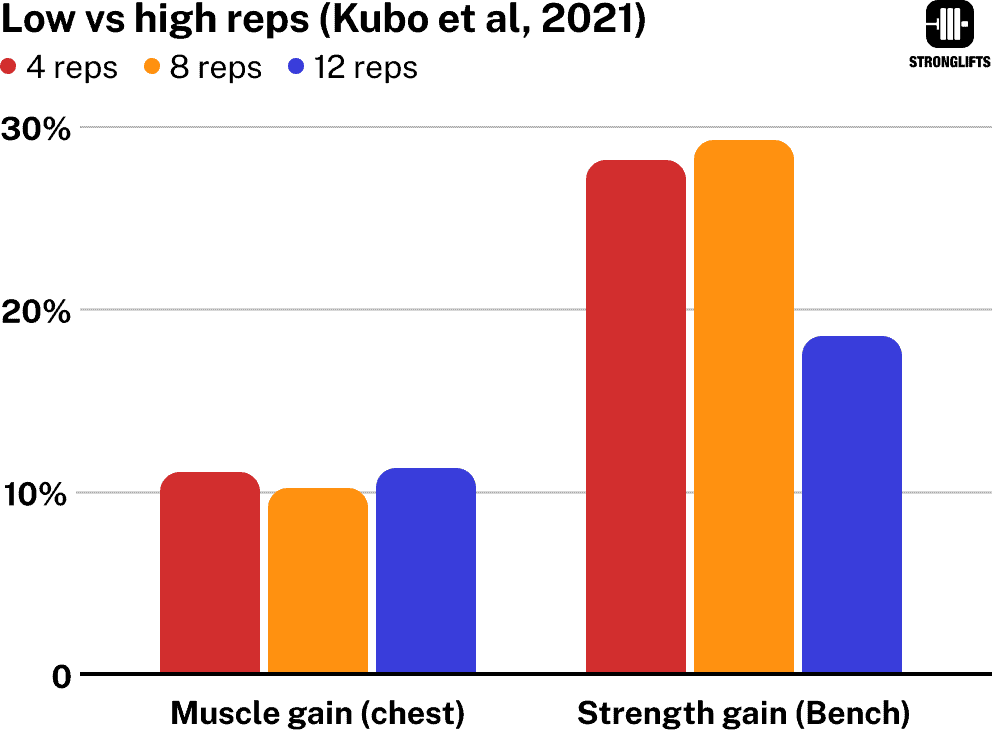
How long should I rest between sets?
Rest as much as you need to complete all your reps on the next set.
Say you do 3×8 Barbell Curls with 100lb. You can complete all sets with one minute rest because the weight is easy to lift. Then keep resting one minute between sets. There’s no need to rest longer if you can complete the sets with less rest. Just make sure you add weight on the bar over the next workouts so the sets become harder to complete and challenge your biceps.
However, say you fail to complete eight reps when you only rest one minute. When you rest for three minutes you’re surprised to find out that you can complete eight reps. Then rest three minutes instead.
Longer rest periods typically help you complete more reps during challenging sets (34). This is because your ATP and PCr energy systems have more time to recover (35). This then results in more total volume lifted. Example…
| Rest | 1min rest | 3min rest |
|---|---|---|
| Set 1 | 8x100lb | 8x100lb |
| Set 2 | 6x100lb | 8x100lb |
| Set 3 | 4x100lb | 8x100lb |
| Volume | 1800lb | 2400lb |
| Difference | +600lb |
Here 3min rest helped you do 600lb more volume. This is because you did eight reps on all three sets. With one minute rest, you failed reps on set two and three. Your ATP-Pc stores were only 75% recovered (35).
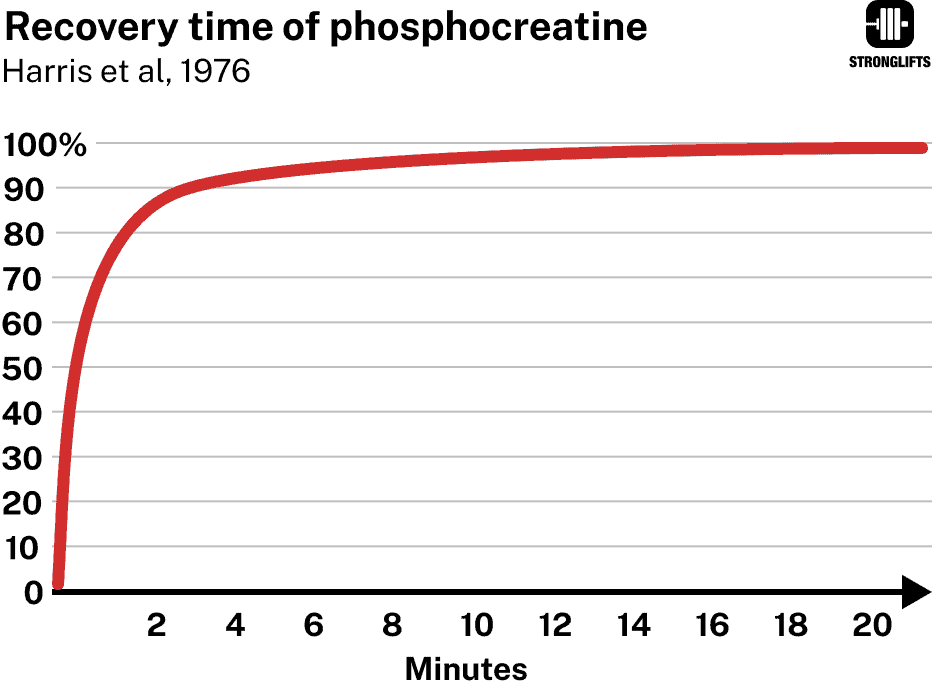
Many people think shorter rest periods save time. The truth is that they don’t because you have to do more sets to get the same volume (36). Longer rest periods are actually more time-efficient because you can do more volume with fewer sets. Some people get confused because they feel more burn or pump when they take shorter rest periods. But again: that’s not what drives muscle growth. Adding weight over time and doing enough volume does (12,13,14).
The best thing you can do to save time in the gym is to be strict with your rest times. The Stronglifts app has a built-in rest timer that automatically notifies you when it’s time for your next set. It will even suggest longer rest periods if you fail to complete a set so you don’t fail the next one too. You can configure the timer by going to Stronglifts – settings – timer.
Join the Stronglifts community to get free access to all the spreadsheets for every Stronglifts program. You’ll also get daily email tips to stay motivated. Enter your email below to sign up today for free.
References
1. de França, Henrique Silvestre et al. “The effects of adding single-joint exercises to a multi-joint exercise resistance training program on upper body muscle strength and size in trained men.” Applied physiology, nutrition, and metabolism = Physiologie appliquee, nutrition et metabolisme vol. 40,8 (2015): 822-6.
2. Barbalho, Matheus et al. “Does the addition of single joint exercises to a resistance training program improve changes in performance and anthropometric measures in untrained men?.” European journal of translational myology vol. 28,4 7827. 2 Nov. 2018.
3. Oliva-Lozano, José M, and José M Muyor. “Core Muscle Activity During Physical Fitness Exercises: A Systematic Review.” International journal of environmental research and public health vol. 17,12 4306. 16 Jun. 2020.
4. Hewit, Jennifer K. “A Comparison of Muscle Activation during the Pull-up and Three Alternative Pulling Exercises.” Journal of Physical Fitness, Medicine & Treatment in Sports, vol. 5, no. 4, 2018.
5. Plotkin, Daniel L et al. “Hip thrust and back squat training elicit similar gluteus muscle hypertrophy and transfer similarly to the deadlift.” bioRxiv : the preprint server for biology 2023.06.21.545949. 5 Jul. 2023.
6. Gentil, Paulo et al. “Effect of adding single-joint exercises to a multi-joint exercise resistance-training program on strength and hypertrophy in untrained subjects.” Applied physiology, nutrition, and metabolism = Physiologie appliquee, nutrition et metabolisme vol. 38,3 (2013): 341-4.
7. Rogers, R. A., et al. “The effect of supplemental isolated weight- training exercises on upper-arm size and upper-body strength.” NSCA Conference. 2000. https://paulogentil.com/pdf/The effect of supplemental isolated weight training exercises on upper arm size and upper body strength.pdf
8. Schoenfeld, Brad J et al. “Calculating Set-Volume for the Limb Muscles with the Performance of Multi-Joint Exercises: Implications for Resistance Training Prescription.” Sports (Basel, Switzerland) vol. 7,7 177. 22 Jul. 2019.
9. Muyor, José M et al. “Evaluation and comparison of electromyographic activity in bench press with feet on the ground and active hip flexion.” PloS one vol. 14,6 e0218209. 14 Jun. 2019.
10. Rodríguez-Ridao, David et al. “Effect of Five Bench Inclinations on the Electromyographic Activity of the Pectoralis Major, Anterior Deltoid, and Triceps Brachii during the Bench Press Exercise.” International journal of environmental research and public health vol. 17,19 7339. 8 Oct. 2020.
11. Ogasawara, Riki et al. “Time course for arm and chest muscle thickness changes following bench press training.” Interventional medicine & applied science vol. 4,4 (2012): 217-20.
12. Schoenfeld, Brad J. “The mechanisms of muscle hypertrophy and their application to resistance training.” Journal of strength and conditioning research vol. 24,10 (2010): 2857-72.
13. DE Camargo, Júlio Benvenutti Bueno et al. “Manipulating Resistance Training Variables to Induce Muscle Strength and Hypertrophy: A Brief Narrative Review.” International journal of exercise science vol. 15,4 910-933. 1 Jul. 2022
14. Bernárdez-Vázquez, Roberto et al. “Resistance Training Variables for Optimization of Muscle Hypertrphy: An Umbrella Review.” Frontiers in sports and active living vol. 4 949021. 4 Jul. 2022.
15. Schoenfeld, Brad J et al. “Dose-response relationship between weekly resistance training volume and increases in muscle mass: A systematic review and meta-analysis.” Journal of sports sciences vol. 35,11 (2017): 1073-1082.
16. Wernbom, Mathias et al. “The influence of frequency, intensity, volume and mode of strength training on whole muscle cross-sectional area in humans.” Sports medicine (Auckland, N.Z.) vol. 37,3 (2007): 225-64.
17. Rønnestad, Bent R et al. “Dissimilar effects of one- and three-set strength training on strength and muscle mass gains in upper and lower body in untrained subjects.” Journal of strength and conditioning research vol. 21,1 (2007): 157-63.
18. Ralston, Grant W et al. “Re-examination of 1- vs. 3-Sets of Resistance Exercise for Pre-spaceflight Muscle Conditioning: A Systematic Review and Meta-Analysis.” Frontiers in physiology vol. 10 864. 24 Jul. 2019.
19. Paulsen, Gøran et al. “The influence of volume of exercise on early adaptations to strength training.” Journal of strength and conditioning research vol. 17,1 (2003): 115-20.
20. Counts, Brittany R et al. “Muscle growth: To infinity and beyond?.” Muscle & nerve vol. 56,6 (2017): 1022-1030.
21. Ogasawara, Riki et al. “Comparison of muscle hypertrophy following 6-month of continuous and periodic strength training.” European journal of applied physiology vol. 113,4 (2013): 975-85.
22. Gentil, Paulo et al. “Nutrition, Pharmacological and Training Strategies Adopted by Six Bodybuilders: Case Report and Critical Review.” European journal of translational myology vol. 27,1 6247. 24 Mar. 2017.
23. Booth, M L et al. “Physical activity preferences, preferred sources of assistance, and perceived barriers to increased activity among physically inactive Australians.” Preventive medicine vol. 26,1 (1997): 131-7.
24. Trost, Stewart G et al. “Correlates of adults’ participation in physical activity: review and update.” Medicine and science in sports and exercise vol. 34,12 (2002): 1996-2001.
25. Silliman, K., K. Rodas-Fortier, and M. Neyman. “Survey of Dietary and Exercise Habits and Perceived Barriers to Following a Healthy Lifestyle in a College Population”. Californian Journal of Health Promotion, Vol. 2, no. 2, June 2004, pp. 10-19.
26. Katch, V L et al. “Muscular development and lean body weight in body builders and weight lifters.” Medicine and science in sports and exercise vol. 12,5 (1980): 340-4.
27. Alves, Ragami C et al. “Training Programs Designed for Muscle Hypertrophy in Bodybuilders: A Narrative Review.” Sports (Basel, Switzerland) vol. 8,11 149. 18 Nov. 2020.
28. Chilibeck, P D et al. “A comparison of strength and muscle mass increases during resistance training in young women.” European journal of applied physiology and occupational physiology vol. 77,1-2 (1998): 170-5.
29. Youdas, James W et al. “Surface electromyographic activation patterns and elbow joint motion during a pull-up, chin-up, or perfect-pullup™ rotational exercise.” Journal of strength and conditioning research vol. 24,12 (2010): 3404-14.
30. Schoenfeld, Brad J et al. “Effects of different volume-equated resistance training loading strategies on muscular adaptations in well-trained men.” Journal of strength and conditioning research vol. 28,10 (2014): 2909-18.
31. Campos, Gerson E R et al. “Muscular adaptations in response to three different resistance-training regimens: specificity of repetition maximum training zones.” European journal of applied physiology vol. 88,1-2 (2002): 50-60.
32. Kubo, Keitaro et al. “Effects of 4, 8, and 12 Repetition Maximum Resistance Training Protocols on Muscle Volume and Strength.” Journal of strength and conditioning research vol. 35,4 (2021): 879-885.
33. Mangine, Gerald T et al. “The effect of training volume and intensity on improvements in muscular strength and size in resistance-trained men.” Physiological reports vol. 3,8 (2015): e12472.
34. Hernandez, Dennis J et al. “Effect of Rest Interval Duration on the Volume Completed During a High-Intensity Bench Press Exercise.” Journal of strength and conditioning research vol. 35,11 (2021): 2981-2987.
35. Harris, R C et al. “The time course of phosphorylcreatine resynthesis during recovery of the quadriceps muscle in man.” Pflugers Archiv : European journal of physiology vol. 367,2 (1976): 137-42.
36. Longo, Ariel Roberth et al. “Volume Load Rather Than Resting Interval Influences Muscle Hypertrophy During High-Intensity Resistance Training.” Journal of strength and conditioning research vol. 36,6 (2022): 1554-1559.




